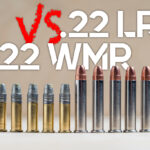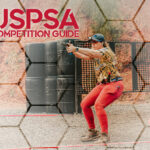
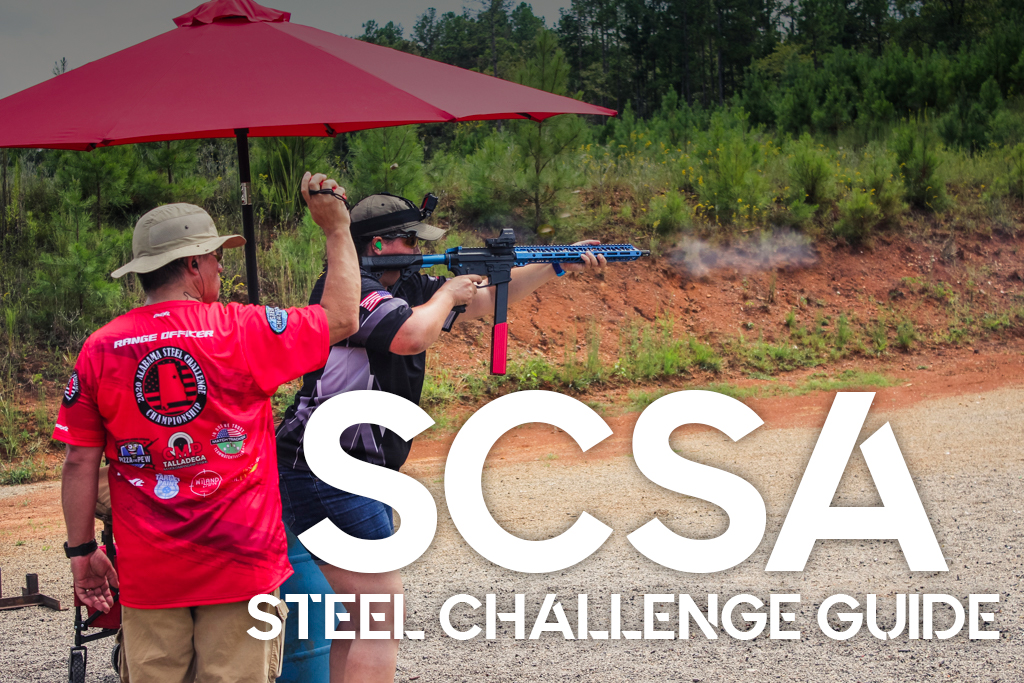
Guest Writer: Kenzie Fitzpatrick
The best introduction to the competitive shooting world is an SCSA Steel Challenge Match. No matter your age, gender, height, athletic ability, this sport is for everyone. The best part about shooting a steel challenge match is the variety of divisions and the low barrier to entry. Just about any pistol, pistol caliber carbine, or rimfire rifle you have will allow you to shoot a match and some divisions don’t even require a holster. If you’re interested in getting started, find a local match online, and get signed up to have some fun.
An SCSA match is a competitive shooting competition made up of stages with only steel targets and a shooting box to shoot the targets from. Each stage requires the shooter to shoot an array of steel targets in any order. To finish the stage, you have to shoot the designated stop plate for the stage. Each stage is scored by time and how many misses you incur before hitting the stop plate. When you hit the stop plate, any targets not hit before that will be penalized as a miss. When you hit the stop plate, this also indicates to the range officer that you are done with that string. The time it took you to shoot the array is ready to be scored.
Steel Challenge Guide
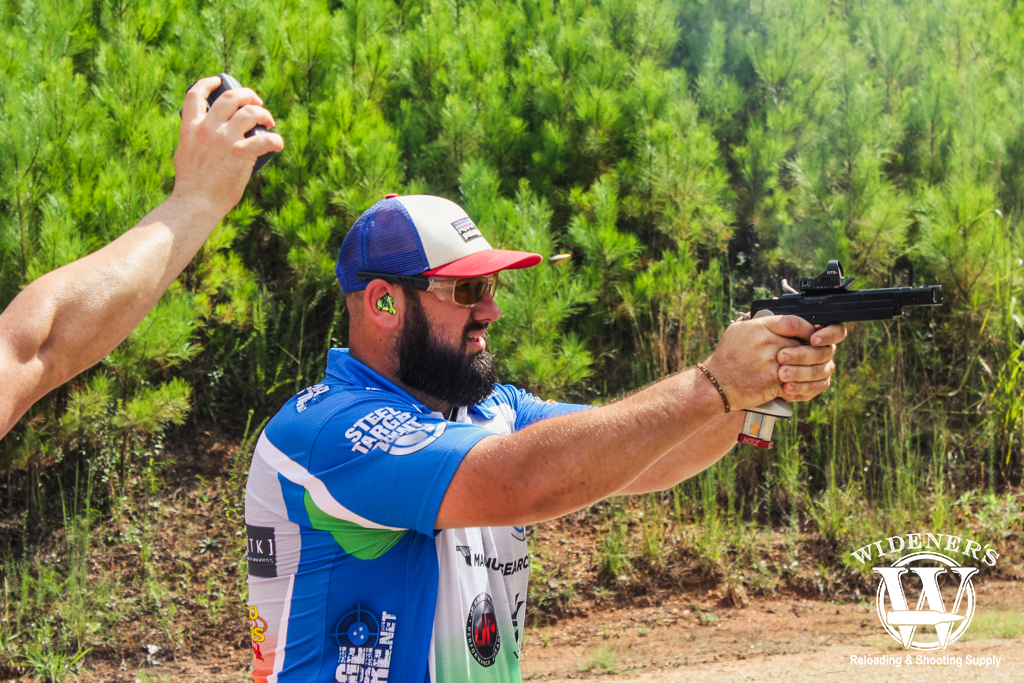
Thinking about shooting Steel Challenge? Take a look at the guide below to make sure you’re ready to go.
While Steel Challenge can be a simple match to start off with, there are some helpful tips to know before you go hit the range.
Steel Challenge Checklist
- No matter the type of shooting competition you go to, it’s always a good idea to read the rules of the competition and the rules of the range you’re at. Steel Challenge has laid out their rules online and in the H1-H9 appendix, you can find all the details on what division your gun of choice will qualify you to shoot.
- Depending on the level of the match you sign up for, in a Steel Challenge match, anything deemed Tier 2 or a higher level match does not allow for coaching or calling of hits/misses. It’s easy to get excited and want to receive help. So starting at a Level 1 match is a great way to learn the ropes.
- Bring enough loaded magazines to the match. If you’re ready to go when it’s your turn to shoot, that’ll help ensure the Steel Challenge match runs smoothly. Each stage requires a minimum of 25 rounds if you shoot it perfectly clean. It’s a good idea to have at least 5 magazines per gun. Or, you can load your magazines to a higher capacity to be able to finish the stage without having to reload your magazines.
- Depending on your division, the start position is either always low ready with the muzzle of the gun pointing at a start indicator on the stage, or drawing from a holster.
- Resetting is part of the sport. In Steel Challenge, that means painting the targets white in between each shooter. My motto is if you’re not able to reset, you aren’t able to shoot either!
What To Bring To A Steel Challenge Match
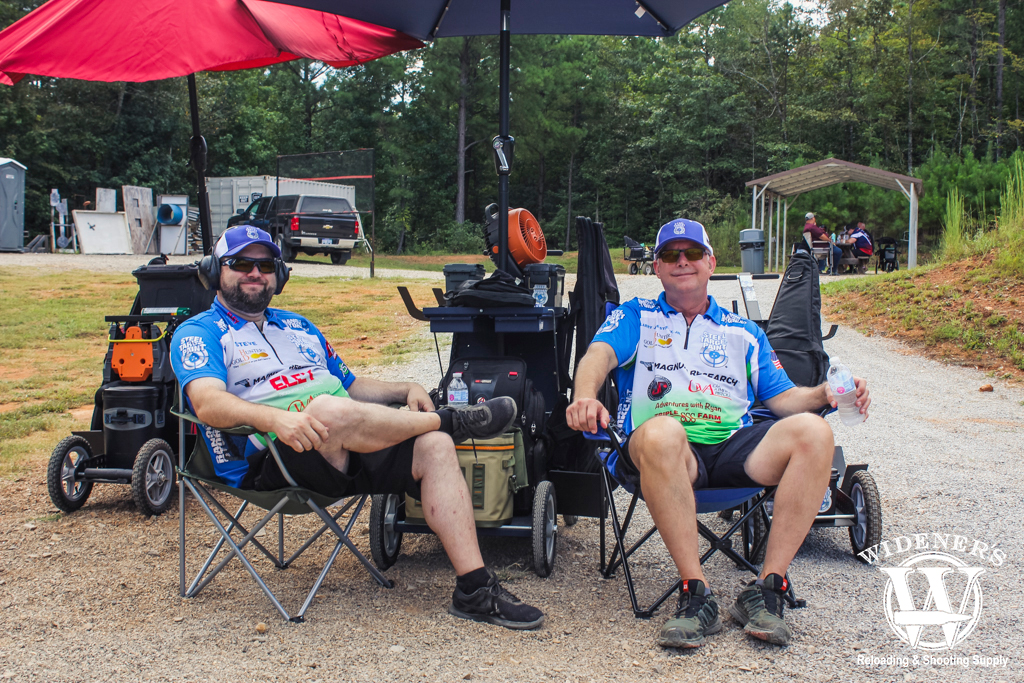
Shooting a Steel Challenge match can be an all-day event. Be sure to plan ahead and pack accordingly.
Even though it’s a fairly simple competitive shooting sport, there’s always gear and equipment to bring in your range bag that is needed or great in case of emergency.
The number one importance of attending a Steel Challenge Match is always maintaining firearm safety rules. If you shoot a long gun division, you must have a chamber flag indicator in your gun at all times. You can also either case your gun in a bag or have it on a “3-gun cart” with the muzzle pointed in a safe direction.
A gun cart makes life a lot easier to attend a match. Most often, competitors will carry their guns, gear, ammunition, range bag, water, and more in one gun cart. This makes it easy to tote everything from stage to stage. Many competitors also shoot multiple divisions at matches. This dedication requires more ammo, guns, and gear so a gun cart is a must-have once you start competing regularly.
Tools & Accessories
If you shoot an optic, you need to bring backup batteries with you. A lens cloth, lens cleaner, and anti-fog product also go a long way in different weather conditions.
A speed loader for magazines is the most underrated tool. Squads in Steel Challenge shooting competitions usually aren’t very big. That means they move faster and your turn to shoot again comes up quickly. I use an UpLula to speed load all my magazines.
I have made it a point to always carry a tool kit complete with screwdrivers, punch kit, a multi-tool, hex keys, a replacement fiber optic, and a lighter to set it. No matter how well you treat your guns and gear, things do break eventually. Tightening down mag pouches, loosening retention on a holster, cleaning a magazine, it all happens often enough to come prepared with all the tools.
The last thing I started carrying to every match I go to is a small cleaning kit. 22 caliber guns are known to jam if you don’t take good care of them and keep them clean. Always carry cleaning solution, a bore snake, and oil. Lubrication is key to guns running smoothly and in all types of weather conditions. So be sure to apply lube before the match starts.
Quick Match Tips
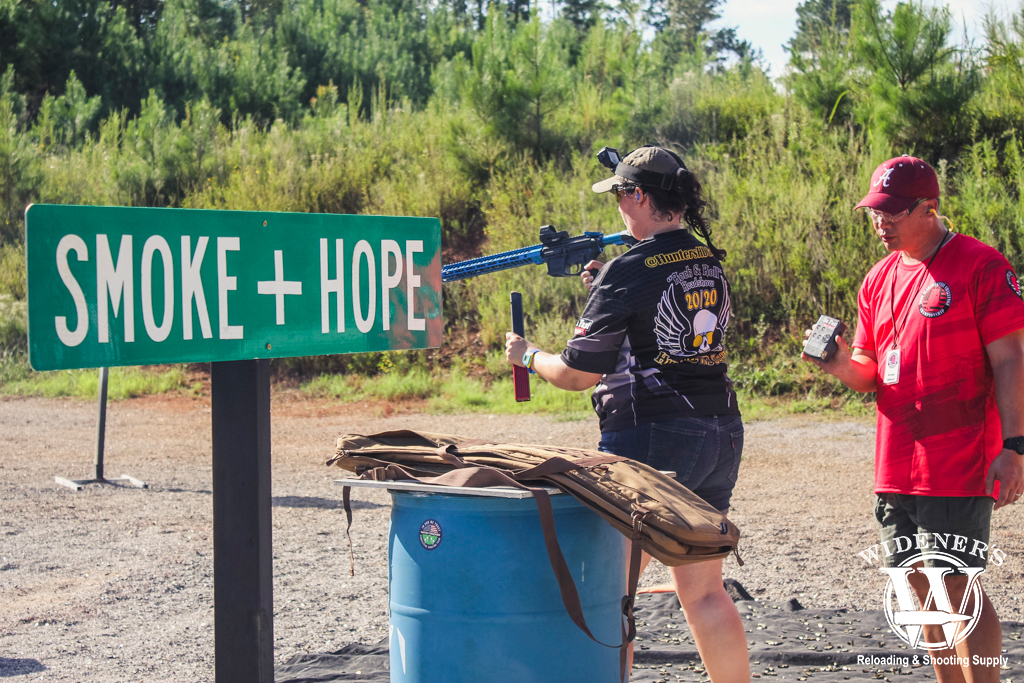
I had a great time competing at the Alabama Steel Challenge Championship.
I recently shot the Alabama Steel Challenge Championship. All I can say is I had a great time shooting in the Pistol Caliber Carbine Open (PCCO) and Rimfire Pistol Irons (RFRI) divisions. While I didn’t break the infamous 60 seconds in a division, I shot a 71.83 in the PCCO division and a 103.47 in the RFRI division.
Here are some things I learned about shooting a Steel Challenge match that may help you at your first match or high-level competition:
Stage Designs
There are only 8 official stage designs for Steel Challenge. Not all matches shoot all 8 stages, but at least 6 of the 8 are required at a Tier 2 match and above. The match I recently shot was a Tier 2 match. If you’re attending one, be aware, you can practice stages all you want before attending the match. These stage designs can also be found in the SCSA Rulebook. Each stage will always have a stop plate in the design which you shoot last to end your time for the string. If you shoot the stop plate before shooting any of the others, each plate not hit before the stop plate is considered a miss and a 3-second penalty.
Stage Times
Bigger matches most often have split squads where you can shoot AM or PM or both back to back. If you’re not a morning person, this is a huge advantage to being able to shoot when you’re the most prepared. I shot both AM and PM and started out with the RFRI gun. I was extremely nervous starting out and took two misses of the whole match on that first stage. Those mistakes cost me a lot of time. My stronger gun is the PCC so I shot it in the afternoon to do my best work with it and the results show that worked well.
While each stage requires you to shoot 5 strings, the best 4 are added together to give you your total time for that stage. This allows you a little room to get warmed up or try and push your speed a little. One of the biggest lessons I learned is to shoot at a consistent speed. Focus on getting your hits versus pushing yourself to do more than your abilities allow you to do.
Tactical Advantages
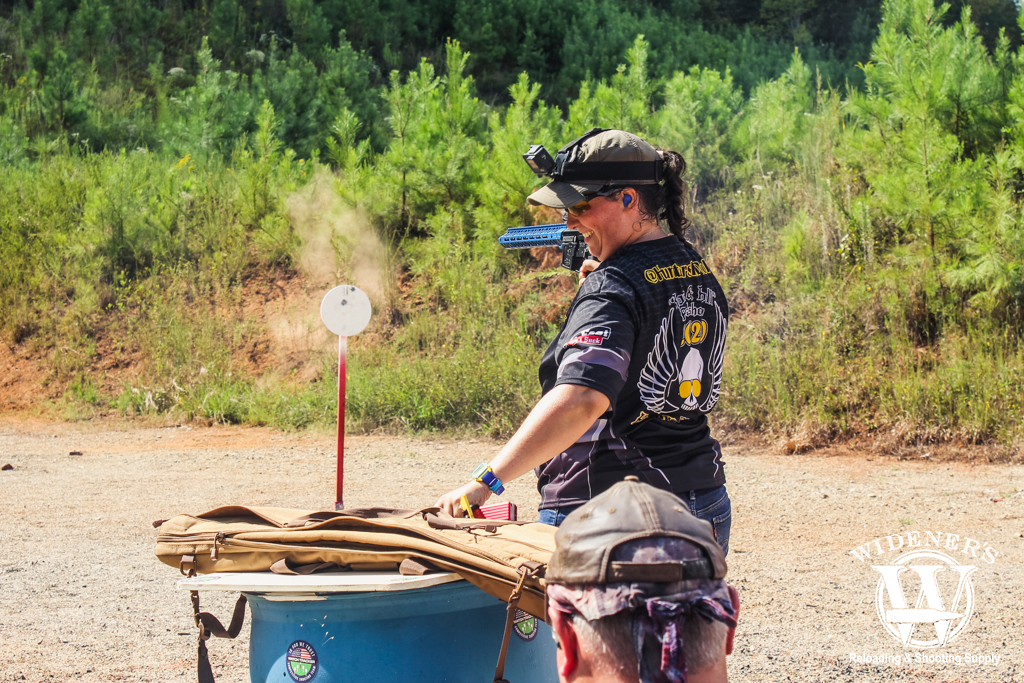
Safety first! Always make sure your gun is clear when moving to different stages during Steel Challenge.
When changing magazines for your next string on a stage, ALWAYS check your chamber to make sure it is clear. I didn’t realize I shot all 10 rounds on a stage with the RFRI pistol so when the timer went off for the second string, I pulled the trigger and found I had to chamber a round on the clock before I was able to start shooting.
If you’re bagging your gun between stages, mark on your bag with duct tape, sharpie, or some other indicator on which way the muzzle is pointing in the bag. When you go to unzip your case, the muzzle should always be pointing downrange. Always leave one side of the case zipped. When you have to re-case your gun, you aren’t flagging your own hand reaching for the zipper in the process.
Ask your range officer for their “cadence” before the match. They may be willing to read your times as well as any misses to you out loud. A range officer’s cadences are their range commands and the speed in which they read them to you. It’s good to know what to expect as everyone is a little different. It’s up to you if you want to know what they’re scoring your times and hits as. When you start competing on a higher level, if an RO marks down a miss, but you saw a hit, you have to arbitrate your score before the next shooter comes up.
Shooter Ready? Have fun!
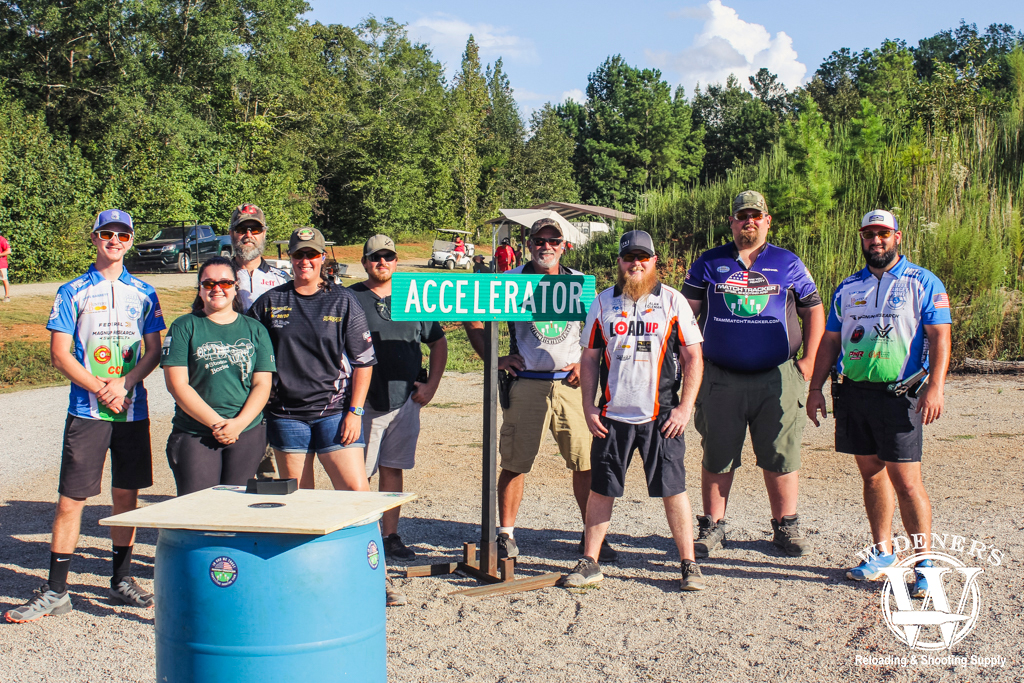
Steel Challenge isn’t all about the targets you plink, it’s also about the friends you make along the way.
There’s a lot to learn and more to pick up as you begin to shoot more matches. Don’t forget to have fun and meet new friends. Remember to ask questions, watch the professionals shoot, and bring a friend with you to the next match!


